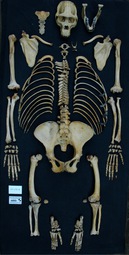IGERT Story
Connecting the dots between gorilla bones and conservation biology
Description
This summer I participated in the Mountain Gorilla Skeletal Project (MGSP), a project that is coordinated by CASHP faculty and works in collaboration with the Rwanda national parks authorities (Rwanda Development Board), Karisoke Research Center, Mountain Gorilla Veterinary Project, the Institute of National Museums of Rwanda, and other institutions in a collective effort to build local capacity to support the long term preservation of mountain gorilla skeletal remains in Rwanda. The scientific goal of the MGSP is to perform research on mountain gorilla skeletons collected from Rwanda’s Volcanoes National Park for insights into the conservation and evolutionary biology of this endangered population of great apes. I participated as part of a team of researchers who were excavating the remains of recently deceased mountain gorillas and preparing them for research to address a number of questions concerning their health status and life history.
Another goal of the MGSP is to build expertise in Rwanda to support the long-term curation and management of this mountain gorilla skeletal collection as a resource for education and research in the country. I participated in this effort by co-teaching a formal course on gorilla osteology, and working with local students from the National University of Rwanda and the Higher Institute of Agriculture and Animal Husbandry, as they were learning both the basics of skeletal anatomy and techniques for skeletal excavation and osteological curation in the field. One day, these students and others like them will take over responsibility for managing this resource, developing exhibits at a recently-opened museum of natural history in Kigali, and generating new research that can contribute towards Rwanda’s efforts to ensure the long-term survival of its mountain gorilla population.
So then, why is it important to preserve the skeletons of great apes, such as mountain gorillas, who have been the focus of long term observations in the wild? This is a question that is beginning to be answered for conservation biologists and wildlife veterinarians who dedicate their life’s work to the continued survival of mountain gorillas in East-Central Africa. In an effort to protect a species from extinction, we must learn everything we can about them. It may not be immediately apparent, but bones and teeth often harbor important information about an animal’s life history long after their death and such information can help us unlock previously unknown characteristics about individuals in populations. Because skeletal ‘hard tissues’ record information about the growth and development of individuals and stress experienced during life, data provided from the skeleton complements information obtained from observations of living gorillas, and can offer unique insight into the impact of life history events and environmental factors on their health and overall well-being. By conserving the bones of these animals after their deaths, and studying them in such a way that allows for us to tell their story, their history, we can learn things about them that we may have never been able to know before, things that could aid in their continued conservation and in better understanding our own evolutionary history.
Over the past four years, the MGSP has established the world’s largest and most complete collection of mountain gorilla skeletons. Given the availability of associated individual records, this represents an unparalleled scientific resource for Rwandan students and scientists, and researchers from the international community, who are interested in studying aspects of great ape skeletal biology, evolution and conservation. This summer alone, I had the opportunity to work with researchers from Rwanda and the United States with a breadth of academic backgrounds, including forensic anthropology, wildlife veterinary science, zoology and conservation biology, and hominid paleobiology. My time spent in Rwanda was both academically and personally fulfilling. I am passionate to learn more about approaches in wildlife conservation, and see the information that we can gain through skeletal biology as a key component to better understanding the peculiarities of the world’s vast biodiversity. I look forward to returning to the project in the future and reuniting with the passionate individuals I had the privilege of learning from and working with who are lucky enough to call Rwanda home.






